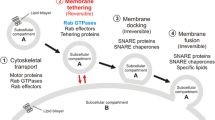Abstract
The cytoplasm of a eukaryotic cell consists of a wide variety of membrane bound cell organelles and continuous flow of proteins amongst these organelles is a major challenge and must be stringently maintained in order to continue the correct biochemical functioning inside a cell. The transportation of various proteins amongst these organelles is facilitated by a vast Tubulo-vesicular network mediated by carrier proteins. The Rabs belong to small G proteins super family involved in the regulation and vesicle transport in between the organelles by shuttling between the active GTP and inactive GDP bound states. In this paper we put forth the homology modeling and docking studies of Rab6A proteins (Mus musculus, Gallus gallus and Caenorhabditis elegans) with GTP, GMP-PNP and GDP molecules and a comparative study between these proteins is done to identify key residues out of which serine of the phosphate binding loop (P – loop) and aspartic acid showed prominent interactions with the GTP, GDP and GMP-PNP nucleotides and cogitate that aspartic acid might also help in the stabilization of the switch I region of the Rab proteins besides serine.







Similar content being viewed by others
References
Grosshans BL, Ortiz D, Novick P (2006) Rabs and their effectors: achieving specificity in membrane traffic. Proc Natl Acad Sci USA 103(32):11821–11827. doi:10.1073/pnas.0601617103
Hutagalung AH, Novick PJ (2011) Role of Rab GTPases in membrane traffic and cell physiology. Physiol Rev 91(1):119–149. doi:10.1152/physrev.00059.2009
Goud B, Zahraoui A, Tavitian A, Saraste J (1990) Small GTP-binding protein associated with Golgi cisternae. Nature 345(6275):553–556. doi:10.1038/345553a0
Martinez O, Schmidt A, Salamero J, Hoflack B, Roa M, Goud B (1994) The small GTP-binding protein rab6 functions in intra-Golgi transport. J Cell Biol 127(6 Pt 1):1575–1588
Goud B, Salminen A, Walworth NC, Novick PJ (1988) A GTP-binding protein required for secretion rapidly associates with secretory vesicles and the plasma membrane in yeast. Cell 53(5):753–768
Salminen A, Novick PJ (1987) A ras-like protein is required for a post-Golgi event in yeast secretion. Cell 49(4):527–538
Takai Y, Sasaki T, Matozaki T (2001) Small GTP-binding proteins. Physiol Rev 81(1):153–208
Lee MT, Mishra A, Lambright DG (2009) Structural mechanisms for regulation of membrane traffic by rab GTPases. Traffic 10(10):1377–1389. doi:10.1111/j.1600-0854.2009.00942.x
Chavrier P, Goud B (1999) The role of ARF and Rab GTPases in membrane transport. Curr Opin Cell Biol 11(4):466–475. doi:10.1016/S0955-0674(99)80067-2
Pfeffer SR (2001) Rab GTPases: specifying and deciphering organelle identity and function. Trends Cell Biol 11(12):487–491
Girod A, Storrie B, Simpson JC, Johannes L, Goud B, Roberts LM, Lord JM, Nilsson T, Pepperkok R (1999) Evidence for a COP-I-independent transport route from the Golgi complex to the endoplasmic reticulum. Nat Cell Biol 1(7):423–430. doi:10.1038/15658
Martinez O, Antony C, Pehau-Arnaudet G, Berger EG, Salamero J, Goud B (1997) GTP-bound forms of rab6 induce the redistribution of Golgi proteins into the endoplasmic reticulum. Proc Natl Acad Sci USA 94(5):1828–1833
Artimo P, Jonnalagedda M, Arnold K, Baratin D, Csardi G, de Castro E, Duvaud S, Flegel V, Fortier A, Gasteiger E, Grosdidier A, Hernandez C, Ioannidis V, Kuznetsov D, Liechti R, Moretti S, Mostaguir K, Redaschi N, Rossier G, Xenarios I, Stockinger H (2012) ExPASy: SIB bioinformatics resource portal. Nucleic Acids Res 40(Web Server issue):W597–W603. doi:10.1093/nar/gks400
Walden M, Jenkins HT, Edwards TA (2011) Structure of the Drosophila melanogaster Rab6 GTPase at 1.4 A resolution. Acta crystallographica section F. Structural Biol Crystallization Commun 67(Pt 7):744–748. doi:10.1107/S1744309111017453
Larkin MA, Blackshields G, Brown NP, Chenna R, McGettigan PA, McWilliam H, Valentin F, Wallace IM, Wilm A, Lopez R, Thompson JD, Gibson TJ, Higgins DG (2007) Clustal W and Clustal X version 2.0. Bioinformatics 23(2):2947–2948. doi:10.1093/bioinformatics/btm404
Eswar N, Webb B, Marti-Renom MA, Madhusudhan MS, Eramian D, Shen M-y, Pieper U, Sali A (2002) Comparative protein structure modeling using modeller. In: Current protocols in bioinformatics. Wiley, New York doi:10.1002/0471250953.bi0506s15
Sali A, Blundell TL (1993) Comparative protein modelling by satisfaction of spatial restraints. J Mol Biol 234(3):779–815. doi:10.1006/jmbi.1993.1626
Laskowski RA, MacArthur MW, Moss DS, Thornton JM (1993) PROCHECK: a program to check the stereochemical quality of protein structures. J Appl Crystallography 26(2):283–291. doi:10.1107/S0021889892009944
Rarey M, Kramer B, Lengauer T, Klebe G (1996) A fast flexible docking method using an incremental construction algorithm. J Mol Biol 261(3):470–489. doi:10.1006/jmbi.1996.0477
Eathiraj S, Pan X, Ritacco C, Lambright DG (2005) Structural basis of family-wide Rab GTPase recognition by rabenosyn-5. Nature 436(7049):415–419. doi:10.1038/nature03798
Pfeffer SR (2005) Structural clues to Rab GTPase functional diversity. J Biol Chem 280(16):15485–15488. doi:10.1074/jbc.R500003200
Chattopadhyay D, Langsley G, Carson M, Recacha R, DeLucas L, Smith C (2000) Structure of the nucleotide-binding domain of Plasmodium falciparum Rab6 in the GDP-bound form. Acta Crystallographica Section D 56(8):937–944. doi:doi:10.1107/S0907444900007575
Dumas JJ, Zhu Z, Connolly JL, Lambright DG (1999) Structural basis of activation and GTP hydrolysis in Rab proteins. Structure 7(4):413–423
Garcia-Saez I, Tcherniuk S, Kozielski F (2006) The structure of human neuronal Rab6B in the active and inactive form. Acta Crystallographica Section D 62(7):725–733. doi:doi:10.1107/S0907444906015319
Brondyk WH, McKiernan CJ, Burstein ES, Macara IG (1993) Mutants of Rab3A analogous to oncogenic Ras mutants. Sensitivity to Rab3A-GTPase activating protein and Rab3A-guanine nucleotide releasing factor. J Biol Chem 268(13):9410–9415
Author information
Authors and Affiliations
Corresponding author
Rights and permissions
About this article
Cite this article
Mulukala Narasimha, S.K., Gunda, S.K. & Shaik, M. Comparative modeling of Rab6 proteins: identification of key residues and their interactions with guanine nucleotides. J Mol Model 19, 1891–1900 (2013). https://doi.org/10.1007/s00894-012-1746-z
Received:
Accepted:
Published:
Issue Date:
DOI: https://doi.org/10.1007/s00894-012-1746-z




